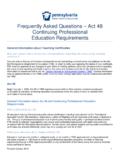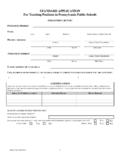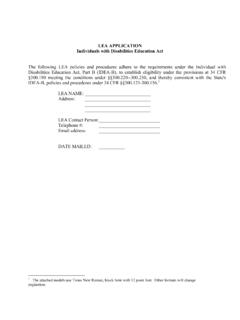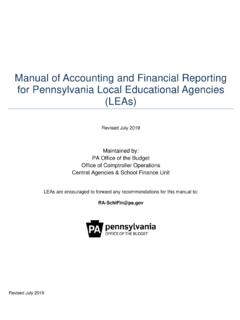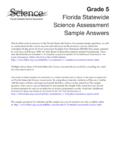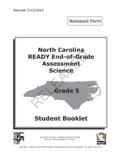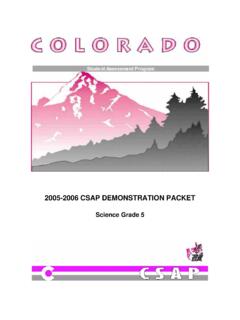Transcription of Science Grade 8 Assessment Anchors and Eligible Content
1 Science Grade 8 Assessment Anchors and Eligible Content Pennsylvania Department of Education Science , Grade The Nature of Science Reporting Category Assessment ANCHOR Reasoning and Analysis Eligible Content 1 Explain, interpret, and apply scientific, environmental, or technological knowledge presented in a variety of formats ( , visuals, scenarios, graphs). Reference: , Distinguish between a scientific theory and an opinion, explaining how a theory is supported with evidence, or how new data/information may change existing theories and practices. Explain how certain questions can be answered through scientific inquiry and/or technological design. Use evidence, such as observations or experimental results, to support inferences about a relationship. Develop descriptions, explanations, predictions, and models using evidence.
2 Identify and explain the impacts of applying scientific, environmental, or technological knowledge to address solutions to practical problems. Reference: , , , Describe the positive and negative, intended and unintended, effects of specific scientific results or technological developments ( , air/space travel, genetic engineering, nuclear fission/fusion, artificial intelligence, lasers, organ transplants). Identify environmental issues and explain their potential long-term health effects ( , pollution, pest controls, vaccinations). Describe fundamental scientific or technological concepts that could solve practical problems ( , Newton s laws of motion, Mendelian genetics). Explain society s standard of living in terms of technological advancements and how these advancements impact on agriculture ( , transportation, processing, production, storage).
3 Pennsylvania Department of Education Science Grade 8 Page 1 Assessment Anchors and Eligible Content 2007 Science , Grade The Nature of Science Reporting Category Assessment ANCHOR Reasoning and Analysis Eligible Content Identify and analyze evidence that certain variables may have caused measurable changes in natural or human-made systems. Reference: , , Use ratio to describe change ( , percents, parts per million, grams per cubic centimeter, mechanical advantage). Use evidence, observations, or explanations to make inferences about change in systems over time ( , carrying capacity, succession, population dynamics, loss of mass in chemical reactions, indicator fossils in geologic time scale) and the variables affecting these changes. Examine systems changing over time, identifying the possible variables causing this change, and drawing inferences about how these variables affect this change.
4 Given a scenario, explain how a dynamically changing environment provides for the sustainability of living systems. Pennsylvania Department of Education Science Grade 8 Page 2 Assessment Anchors and Eligible Content 2007 Science , Grade The Nature of Science Reporting Category Assessment ANCHOR Processes, Procedures, and Tools of Scientific Investigations Eligible Content Apply knowledge of scientific investigation or technological design in different contexts to make inferences to solve problems. Reference: , , , Use evidence, observations, or a variety of scales ( , mass, distance, volume, temperature) to describe relationships. Use space/time relationships, define concepts operationally, raise testable questions, or formulate hypotheses. Design a controlled experiment by specifying how the independent variables will be manipulated, how the dependent variable will be measured, and which variables will be held constant.
5 Interpret data/observations; develop relationships among variables based on data/observations to design models as solutions. Use evidence from investigations to clearly communicate and support conclusions. Identify a design flaw in a simple technological system and devise possible working solutions. Apply appropriate instruments for a specific purpose and describe the information the instrument can provide. Reference: , , Describe the appropriate use of instruments and scales to accurately and safely measure time, mass, distance, volume, or temperature under a variety of conditions. Apply appropriate measurement systems ( , time, mass, distance, volume, temperature) to record and interpret observations under varying conditions. Describe ways technology ( , microscope, telescope, micrometer, hydraulics, barometer) extends and enhances human abilities for specific purposes.
6 Pennsylvania Department of Education Science Grade 8 Page 3 Assessment Anchors and Eligible Content 2007 Science , Grade The Nature of Science Reporting Category Assessment ANCHOR Systems, Models, and Patterns Eligible Content Explain the parts of a simple system, their roles, and their relationships to the system as a whole. Reference: , , , , Describe a system ( , watershed, circulatory system, heating system, agricultural system) as a group of related parts with specific roles that work together to achieve an observed result. Explain the concept of order in a system [ , (first to last: manufacturing steps, trophic levels); (simple to complex: cell, tissue, organ, organ system)]. Distinguish among system inputs, system processes, system outputs, and feedback ( , physical, ecological, biological, informational).
7 Distinguish between open loop ( , energy flow, food web) and closed loop ( , materials in the nitrogen and carbon cycles, closed-switch) systems. Explain how components of natural and human-made systems play different roles in a working system. Apply knowledge of models to make predictions, draw inferences, or explain technological concepts. Reference: , , Describe how scientists use models to explore relationships in natural systems ( , an ecosystem, river system, the solar system). Describe how engineers use models to develop new and improved technologies to solve problems. Given a model showing simple cause- and-effect relationships in a natural system, predict results that can be used to test the assumptions in the model ( , photosynthesis, water cycle, diffusion, infiltration). Pennsylvania Department of Education Science Grade 8 Page 4 Assessment Anchors and Eligible Content 2007 Science , Grade The Nature of Science Reporting Category Assessment ANCHOR Systems, Models, and Patterns Eligible Content Describe repeated processes or recurring elements in natural, scientific, and technological patterns.
8 Reference: , Identify and describe patterns as repeated processes or recurring elements in human-made systems ( , trusses, hub-and-spoke system in communications and transportation systems, feedback controls in regulated systems). Describe repeating structure patterns in nature ( , veins in a leaf, tree rings, crystals, water waves) or periodic patterns ( , daily, monthly, annually). Pennsylvania Department of Education Science Grade 8 Page 5 Assessment Anchors and Eligible Content 2007 Science , Grade Biological sciences Reporting Category Assessment ANCHOR Structure and Function of Organisms Eligible Content Describe and compare structural and functional similarities and differences that characterize diverse living things. Reference: , , , Describe the structures of living things that help them function effectively in specific ways ( , adaptations, characteristics).
9 Compare similarities and differences in internal structures of organisms ( , invertebrate/vertebrate, vascular/nonvascular, single-celled/multi-celled) and external structures ( , appendages, body segments, type of covering, size, shape). Apply knowledge of characteristic structures to identify or categorize organisms ( , plants, animals, fungi, bacteria, and protista). Identify the levels of organization from cell to organism and describe how specific structures (parts), which underlie larger systems, enable the system to function as a whole. Pennsylvania Department of Education Science Grade 8 Page 6 Assessment Anchors and Eligible Content 2007 Science , Grade Biological sciences Reporting Category Assessment ANCHOR Continuity of Life Eligible Content Explain the basic concepts of natural selection.
10 Reference: , , Explain how inherited structures or behaviors help organisms survive and reproduce in different environments. Explain how different adaptations in individuals of the same species may affect survivability or reproduction success. Explain that mutations can alter a gene and are the original source of new variations. Describe how selective breeding or biotechnology can change the genetic makeup of organisms. Explain that adaptations are developed over long periods of time and are passed from one generation to another. Explain how a set of genetic instructions determines inherited traits of organisms. Reference: Identify and explain differences between inherited and acquired traits. Recognize that the gene is the basic unit of inheritance, that there are dominant and recessive genes, and that traits are inherited.


